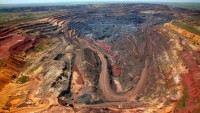China Rare Earth Producers Merge to Boost Competitiveness
| Vittorio Hernandez | | Dec 14, 2014 04:36 AM EST |
(Photo : Reuters) A villager looks towards a rare earth smelting plant as he takes a break from shovelling cast-off tailings of crushed mineral ore that contain rare earth metals in Xinguang Village, located on the outskirts of the city of Baotou in China's Inner Mongolia Autonomous Region in this October 31, 2010 picture. The massive Baogang corporation, located on the outskirts of Baotou city, churns out rare earth metals on a vast scale, and villagers living near the smelting plants and a vast tailings dam used to dump the black refuse from ore processing said the rare earths boom was threatening their livelihood and health. Air and water toxins from the plants and dam were poisoning them, their water, crops and children, they said. China supplies 97 percent of rare earths used worldwide, and they go into magnets, bearings and high-tech components that go into computers, vehicles and, increasingly, clean energy technology such as wind turbines and hybrid cars. Picture taken October 31, 2010. TO MATCH STORY CHINA-RAREEARTHS/ REUTERS/David Gray (CHINA - Tags: ENERGY ENVIRONMENT EMPLOYMENT BUSINESS SOCIETY)
A World Trade Organization (WTO) ruling in March against rare earth export quotas from China has failed to reduce the Asian giant's dominance of the industry, according to Rare Earth Investing News. It currently accounts for more than 90 percent of the global supply but has little control of pricing over the commodity used for the production of high-tech gadgets.
Like Us on Facebook
Despite the higher production by the two major rare earths producers outside China, Lynas of Australia and Molycorp of the U.S., their shares still declined by about 85 percent. This development failed to reduce China's share in the global rare earths markets to 65 percent as forecast by China Minmetals to be the likely impact of the WTO decision.
Chinese producers could even become more competitive in 2015 as more rare earths companies merger. On Friday, Baogang Rare Earth Group, based in the Inner Mongolia Autonomous Region in North China. Baogang announced it changed its company name to China North Rare Earth Group Co. Ltd. as a result of its merger with five smaller firms in Inner Mongolia and Gansu Province, reports China Daily.
Baogang is the top producer of light rare earths products in China and a leading rare earths producer and processor in the international market since it owns the largest reserve of rare earths in the world.
Besides Baogang, two other major Chinese rare earths companies - Aluminum Corporation of China and Xiamen Tungsten Co. Ltd. - are expected to also join forces by the end of 2014.
The mergers are considered healthy for Chinese companies, said Yang Zhanfeng, dean of Baotou Research Institute for Rare Earths, since it consolidate resources and lead to favorable business environment for local rare earths companies.
Industry experts pointed out that the WTO ruling is significant, but they doubt if it could change the clout that China enjoys. It would be "borderline delusional," Stormcrow Capital President and Director John Hykawy told Rare Earths Investing News in an older issue, to expect the WTO decision to impact China's dominance of the industry.
Hykawy added that as more Chinese firms merge, production would be overseen by mid-level managers who would likely follow export orders, whether there is a WTO quota or none, in the hope of being promoted to higher positions.
Tagsrare earths, Baogang, WTO ruling
©2015 Chinatopix All rights reserved. Do not reproduce without permission
EDITOR'S PICKS
-

Did the Trump administration just announce plans for a trade war with ‘hostile’ China and Russia?
-

US Senate passes Taiwan travel bill slammed by China
-

As Yan Sihong’s family grieves, here are other Chinese students who went missing abroad. Some have never been found
-

Beijing blasts Western critics who ‘smear China’ with the term sharp power
-

China Envoy Seeks to Defuse Tensions With U.S. as a Trade War Brews
-

Singapore's Deputy PM Provides Bitcoin Vote of Confidence Amid China's Blanket Bans
-

China warns investors over risks in overseas virtual currency trading
-

Chinese government most trustworthy: survey
-

Kashima Antlers On Course For Back-To-Back Titles
MOST POPULAR
LATEST NEWS
Zhou Yongkang: China's Former Security Chief Sentenced to Life in Prison

China's former Chief of the Ministry of Public Security, Zhou Yongkang, has been given a life sentence after he was found guilty of abusing his office, bribery and deliberately ... Full Article
TRENDING STORY

China Pork Prices Expected to Stabilize As The Supplies Recover

Elephone P9000 Smartphone is now on Sale on Amazon India

There's a Big Chance Cliffhangers Won't Still Be Resolved When Grey's Anatomy Season 13 Returns

Supreme Court Ruled on Samsung vs Apple Dispute for Patent Infringement

Microsoft Surface Pro 5 Rumors and Release Date: What is the Latest?












